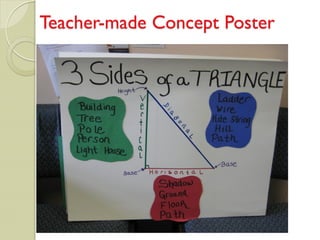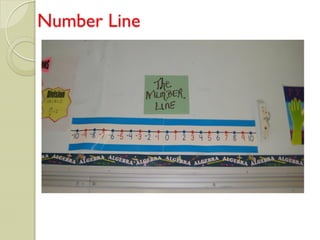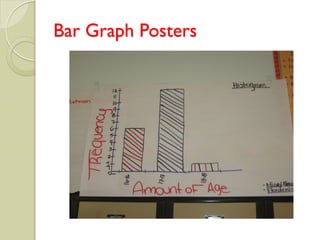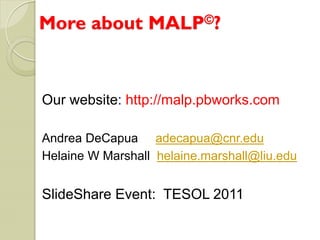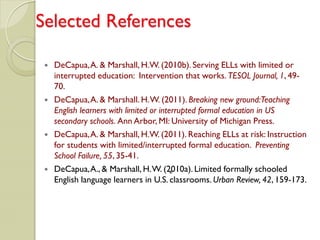Preparing educators to teach students with limited/interrupted formal education tesol 2011
- 1. Preparing Educators to Teach Students with Limited/Interrupted Formal Education TESOL Convention New Orleans March 17, 2011 Andrea DeCapua The College of New Rochelle Helaine W. Marshall Long Island University
- 2. Mutually Adaptive Learning Paradigm – MALP© • Instructional Model • Transitional approach to close achievement gap • Elements from students’ learning paradigm • Elements from U.S. learning paradigm (Marshall, 1998; DeCapua & Marshall, 2011)
- 3. MALP© A. Accept Conditions for Learning B. Combine Processes for Learning C. Focus on New Activities for Learning
- 4. MALP Teacher Planning Checklist © A. Accept Conditions for Learning A1. I am making this lesson/project immediately relevant to my students. A2. I am helping students develop and maintain interconnectedness. B. Combine Processes for Learning B1. I am incorporating both shared responsibility and individual accountability. B2. I am scaffolding the written word through oral interaction. C. Focus on New Activities for Learning C1. I am focusing on tasks requiring academic ways of thinking. C2. I am making these tasks accessible to my students with familiar language and content. © University of Michigan Press, 2011. DeCapua & Marshall. Breaking New Ground: Teaching Students with Limited or Interrupted Formal Education in US Secondary Schools
- 5. Before MALP© Training: Carol’s Lesson on U.S. Symbols Objectives: Students will be able to describe what “symbol” means identify important US symbols explain meaning of US symbols
- 7. American Symbols Lesson Carol’s Self-Assessment She thought she was meeting their needs PPT presentation with images Focus on oral language use Focus on new vocabulary Focus on individual student participation
- 8. American Symbols Lesson MALP© Assessment For SLIFE, lesson lacked: familiar conditions for learning transition to new processes for learning new activities for learning
- 9. After MALP© Training: Carol’s MALP© Social Studies Project Objectives: Students will be able to: describe the everyday life of Civil War soldiers compare/contrast it with their own lives today
- 10. A. Accept Conditions for Learning interconnectedness immediate relevance
- 11. B. Combine Processes for Learning shared + individual responsibility oral + written
- 12. C. New Activities for Learning academic tasks familiar language and content
- 13. And now on to math . . .
- 14. Gloria’s Math Class • Mainstream math teacher • Section of beginner ELLs with SLIFE • MALP© training • Shift in pedagogy to incorporate MALP© Let’s peek into Gloria’s classroom…
- 15. High School MALP© Math Classroom Word wall Calendar Sentence frames Teacher-made concept posters Student–produced posters
- 16. Word Wall
- 17. Class Calendar
- 18. Sentence Frames
- 20. Number Line
- 21. Number Lines
- 22. Venn Diagrams
- 23. Like and Unlike Terms Posters
- 26. © Mutually Adaptive Learning Paradigm – MALP Teacher Planning Checklist A. Accept Conditions for Learning A1. I am making this lesson/project immediately relevant to students. A2. I am helping students develop and maintain interconnectedness. B. Combine Processes for Learning B1. I am incorporating shared responsibility and individual accountability. B2. I am scaffolding the written word through oral interaction. C. Focus on New Activities for Learning C1. I am focusing on tasks requiring academic ways of thinking. C2. I am making these tasks accessible with familiar language and content. DeCapua, A. & Marshall. H. W. (2011). Breaking new ground:Teaching English learners with limited or interrupted formal education in US secondary schools. Ann Arbor, MI: University of Michigan Press.
- 27. More about MALP©? Our website: http://malp.pbworks.com Andrea DeCapua adecapua@cnr.edu Helaine W Marshall helaine.marshall@liu.edu SlideShare Event: TESOL 2011
- 28. Selected References DeCapua, A. & Marshall, H.W. (2010b). Serving ELLs with limited or interrupted education: Intervention that works. TESOL Journal, 1, 49- 70. DeCapua, A. & Marshall. H. W. (2011). Breaking new ground:Teaching English learners with limited or interrupted formal education in US secondary schools. Ann Arbor, MI: University of Michigan Press. DeCapua, A. & Marshall, H.W. (2011). Reaching ELLs at risk: Instruction for students with limited/interrupted formal education. Preventing School Failure, 55, 35-41. DeCapua, A., & Marshall, H. W. (2010a). Limited formally schooled * English language learners in U.S. classrooms. Urban Review, 42, 159-173.
- 29. References (cont’d) DeCapua, A., Smathers, W. & Tang, F. (2007). Addressing the challenges and needs of students with interrupted formal education (SIFE). Educational Policy & Leadership, 65, 40–46. Marshall, H.W. & DeCapua A. 2010). The newcomer booklet: A Project for limited formally schooled students. ELT Journal, 64. 396-404. Marshall, H.W., DeCapua, A., & Antolini, C. (2010) Building literacy for SIFE through social studies. Educator’s Voice, 3, 56-65. Marshall, H. W. (1998). A mutually adaptive learning paradigm (MALP) for Hmong students. Cultural Circles, 3, 134-141.


















